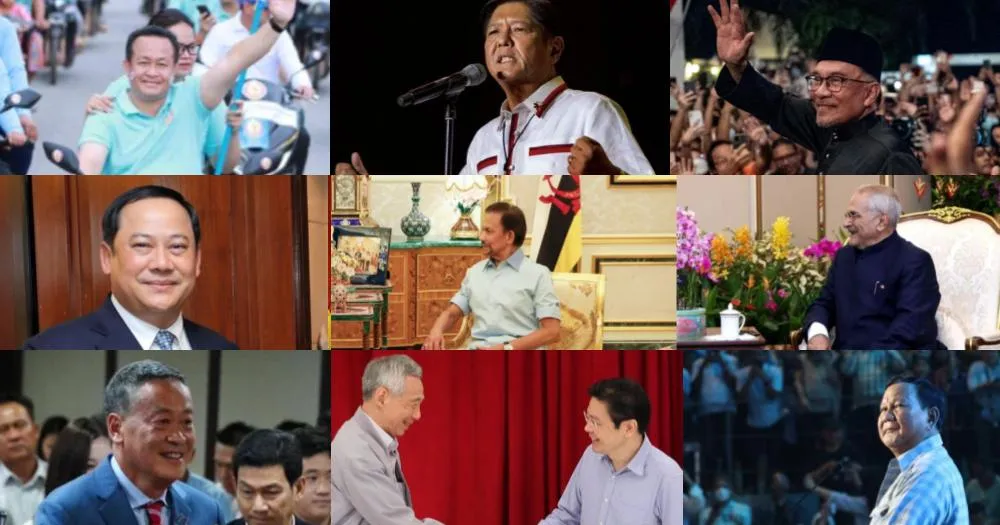评论:随着李总理卸任,2022年起所有东盟国家(除文莱外)都将迎来领导层更迭
随着李总理卸任,2022年起所有东盟国家(除文莱外)都将迎来领导层更迭

变革之风似乎不仅席卷了新加坡,也席卷了东盟(亚细安)。 黄循财将是自 2022 年以来东盟的第九个政权更替,或者说第十个,这取决于你想把越南算在内。 事实上,如果放宽到 2021 年起,整个东盟(除文莱外)的政府领导层都已经变动、或将在今年年底发生变化。 老领导 李显龙总理和印尼总统佐科-维多多(Joko Widodo)是东盟内任期最长的两位“老首长“,他们将于 2024 年卸任。 2024 年 5 月,李总理将让位给副总理兼财政部长黄循财;2024 年 10 月,佐科威将把总统职位交给在 2024 年 2 月大选中获胜的国防部长普拉博沃-苏比安托。 新加坡总理李显龙和印尼总理佐科威作为各自国家和东盟的领导人,拥有三十多年的从政经验。 最有经验的苏丹哈桑纳尔-博尔基亚 如果不把文莱苏丹哈桑纳尔-博尔基亚算在内,现在这两位即将离任的领导人退下来之后,所有东盟新领导人的经验加起来也不及他们经验的一半。 身兼文莱国家元首(苏丹)和政府首脑(首相)的博尔基亚拥有 40 年的从政经验。 这甚至超过了李总理的 20 年,他将成为东盟地区任职时间最长的领导人。 2022 年的东盟 马来西亚、菲律宾和东帝汶都在 2022 年举行了选举,其政府首脑也随之发生了变化。 对于那些统计的人来说,这已经是五个变动了。 在马来西亚和菲律宾,总理安瓦尔-易卜拉欣(Anwar Ibrahim)和总统小费迪南德-马科斯(Ferdinand“Bongbong“Marcos Jr)几十年来一直参与本国政治,但这是他们第一次担任首脑。 自 20 世纪 90 年代被解除副总理职务并成为反对党领袖以来,安瓦尔一直领导着马来西亚的改革运动。 从那时起,他就领导了一场长期的政治改革运动,他在 2022 年当选总理被认为是这些努力的顶峰,尽管许多盟友从那时起就对结果表示失望。 就连马来西亚的国家元首也发生了变化,柔佛苏丹易卜拉欣-依斯干达成为新任国王,并承诺将采取强有力的措施。 菲律宾、东帝汶和老挝 与此同时,小马科斯是菲律宾强人费迪南德-马科斯的儿子,费迪南德-马科斯本人在 20 世纪 80 年代被废黜。 他是在 2022 年取得前所未有的压倒性胜利后上台的。 东帝汶总统若泽-拉莫斯-奥尔塔(Jose Ramos-Horta)曾担任过东帝汶总统。 不过,东帝汶尚未正式成为东盟国家,但已被该地区集团接纳。 另外值得注意的是,老挝于 2022 年 12 月选出了新总理 Sonexay Siphandone。 2023 年的东盟 2023 年也特别繁忙,柬埔寨和泰国都有新总理上任。 就柬埔寨而言,洪马内是长期担任首相的洪森的儿子,人们可能会说他代表的是连续性而非变革。 这在一定程度上可能是对的,但他也代表了一种更新、更年轻的政治力量,并很有可能至少在一定程度上尝试柬埔寨的政治现代化。 但洪森并没有完全退出,他仍然留在柬埔寨内阁中,作为一种资源。 李显龙在把权力移交给黄循财后,也将作为高级部长留在内阁。 泰国和越南 在泰国,总理赛塔·他威信(Srettha Thavisin)来自有影响力的西那瓦家族支持的政党。 虽然他们可能比受欢迎的前进党(Move Forward Party)更加保守,但与2014年军事政变推翻上届西那瓦支持的政府后上台执政的联盟相比,他们代表了一种明显的转变。 同样值得注意的是越南,反腐大清洗给越南上层带来了不寻常的波动,在不到一年的时间里,国家主席职位发生了两次变动,一次是在2023年,另一次是在2024年。 越南目前没有常任国家主席,由武氏映春担任代主席。 变化更大 政治革新本身并不令人惊讶,但几乎整个地区在三年内更换领导层的巧合却令人瞩目。 这份名单中不包括缅甸,该国在 2021 年发生了政变,此后内战不断。 经验知识 在许多情况下,如新加坡、柬埔寨,其次是泰国和印度尼西亚,政府在许多方面具有延续性,这意味着机构知识和经验并没有完全消失,而是进入了背景之中。 在其他国家,如菲律宾、马来西亚,其次是泰国和印度尼西亚,领导层和执政党的更迭意味着前几届政府的治理知识大部分被封存起来。 但这也是改变东盟经商方式的机会。 一个例子就是小马科斯和他的前任罗德里戈-杜特尔特之间的区别。后者似乎更倾向于与中国建立关系,而前者则回归到以美国为中心的外交政策。 另一个例子是马来西亚如何在白礁问题上划清界限。 此前,马来西亚曾向国际法院提起诉讼,试图夺回对该岛的控制权,而安瓦尔似乎改变了言论,接受了国际法院对白礁岛的裁决。 在政治过渡时期,随着领导层引入新理念和新方法,这些方法的改变是最可行的。 东盟不是一个几乎一成不变的地区,但这种新鲜血液的集中注入应该会对其未来产生明显的影响,而东盟人民也在期待着其结果。

